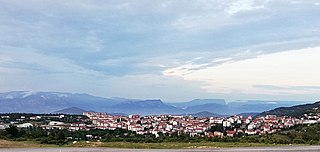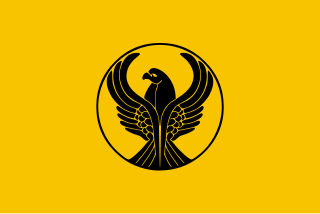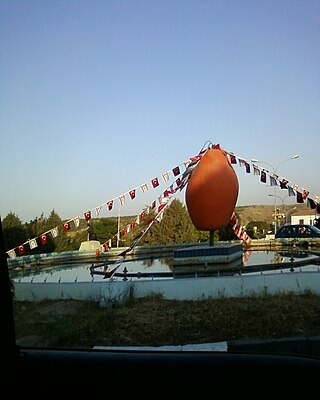
Osman I or Osman Ghazi was the founder of the Ottoman Empire. While initially a small Turkoman principality during Osman's lifetime, his beylik transformed into a vast empire in the centuries after his death. It existed until 1922 shortly after the end of World War I, when the sultanate was abolished.

Paros is a Greek island in the central Aegean Sea. Part of the Cyclades island group, it lies to the west of Naxos, from which it is separated by a channel about 8 kilometres wide. It lies approximately 150 km south-east of Piraeus. The Municipality of Paros includes numerous uninhabited offshore islets totaling 196.308 square kilometres (75.795 sq mi) of land. Its nearest neighbor is the municipality of Antiparos, which lies to its southwest. In ancient Greece, the city-state of Paros was located on the island.

Söğüt is a town in Bilecik Province, Turkey. It is the seat of Söğüt District. Its population is 13,566 (2021). The mayor is İsmet Sever (MHP), elected in 2019.

Rūm, also romanized as Roum, is a derivative of Parthian (frwm) terms, ultimately derived from Greek Ῥωμαῖοι. Both terms are endonyms of the pre-Islamic inhabitants of Anatolia, the Middle East and the Balkans and date to when those regions were parts of the Eastern Roman Empire.

Rumelia was the name of a historical region in Southeastern Europe that was administered by the Ottoman Empire, roughly corresponding to the Balkans. In its wider sense, it was used to refer to all Ottoman possessions and vassals in Europe. These would later be geopolitically classified as "the Balkans", although Hungary, Moldova and Slovakia are often excluded. During the period of its existence, Rumelia was more often known in English as Turkey in Europe.

Akçakoca is a town in Düzce Province, in the West Black Sea Region of Turkey, located about 200 km east of Istanbul. It is the seat of Akçakoca District. Its population is 27,878 (2022). The town was named after a Turkish chieftain of the 14th century CE who captured the area for the Ottoman Empire, and sports a statue in his honor. The town features a modern mosque of unusual design. Tourist attractions include beaches and a small ruined Genoese castle. It is the regional center of hazelnut cultivation.

Anatolian beyliks were small principalities in Anatolia governed by beys, the first of which were founded at the end of the 11th century. A second and more extensive period of establishment took place as a result of the decline of the Seljuq Sultanate of Rûm in the latter half of the 13th century.

Bilecik Province is a province in midwest Turkey, neighboring Bursa to the west, Kocaeli and Sakarya to the north, Bolu to the east, Eskişehir to the southeast and Kütahya to the south. Its area is 4,179 km2, and its population is 228,673 (2022). Most of the province laid down in Marmara Region but eastern parts of Gölpazarı and Söğüt district and districts of İnhisar and Yenipazar remained in Black Sea Region, smaller southeastern parts of Bozüyük and Söğüt remained in Central Anatolia Region and smaller southwestern part of Bozüyük remained in Aegean Region.

The Pontic Greeks also Pontian Greeks or simply Pontians, are an ethnically Greek group indigenous to the region of Pontus, in northeastern Anatolia. They share a common Pontic Greek culture that is distinguished by its music, dances, cusine, and clothing. Folk dances, such as the Serra, and traditional musical instruments, like the Pontic lyra, remain important to Pontian diaspora communities. Pontians traditionally speak Pontic Greek, a modern Greek variety, that has developed remotely in the region of Pontus. Commonly known as Pontiaka, it is traditionally called Romeika by its native speakers.

Greek Muslims, also known as Grecophone Muslims, are Muslims of Greek ethnic origin whose adoption of Islam dates to the period of Ottoman rule in the southern Balkans. They consist primarily of Ottoman-era converts to Islam from Greek Macedonia, Crete, and northeastern Anatolia.

Tekkeköy is a municipality and district of Samsun Province, Turkey. Its area is 326 km2, and its population is 56,318 (2022). It covers the easternmost part of the city of Samsun.

Lefka is a town in Cyprus, overlooking Morphou Bay. It is under the de facto control of Northern Cyprus. In 2011, the town proper had 3,009 inhabitants. It is the capital of the Lefke District of Northern Cyprus, having been a sub-district centre in the Güzelyurt District until the establishment of the district in 2016.

İznik is a municipality and district of Bursa Province, Turkey. Its area is 753 km2, and its population is 44,236 (2022). The town is at the site of the ancient Greek city of Nicaea, from which the modern name derives. The town lies in a fertile basin at the eastern end of Lake İznik, with ranges of hills to the north and south. As the crow flies, the town is only 90 kilometres southeast of Istanbul but by road it is 200 km around the Gulf of İzmit. It is 80 km by road from Bursa.

Ottoman Greeks were ethnic Greeks who lived in the Ottoman Empire (1299–1922), much of which is in modern Turkey. Ottoman Greeks were Greek Orthodox Christians who belonged to the Rum Millet. They were concentrated in eastern Thrace, and western, central, and northeastern Anatolia. There were also sizeable Greek communities elsewhere in the Ottoman Balkans, Ottoman Armenia, Ottoman Syria and the Ottoman Caucasus, including in what, between 1878 and 1917, made up the Russian Caucasus province of Kars Oblast, in which Pontic Greeks, northeastern Anatolian Greeks, and Caucasus Greeks who had collaborated with the Russian Imperial Army in the Russo-Turkish War of 1828–1829 were settled in over 70 villages, as part of official Russian policy to re-populate with Orthodox Christians an area that was traditionally made up of Ottoman Muslims and Armenians.
Cappadocian Greeks, also known as Greek Cappadocians or simply Cappadocians, are an ethnic Greek community native to the geographical region of Cappadocia in central-eastern Anatolia; roughly the Nevşehir and Kayseri provinces, and their surroundings, in modern-day Turkey. There had been a continuous Greek presence in Cappadocia since antiquity, and the indigenous populations of Cappadocia, some of whose Indo-European languages may have been closely related to Greek, became entirely Greek-speaking by at least the 5th century.

Tirilye is a neighbourhood of the municipality and district of Mudanya, Bursa Province, Turkey. Its population is 1,409 (2022). With the 2013 Turkish local government reorganisation, its town (belde) status and its municipality (belediye) were abolished, and it was made a neighbourhood (mahalle). It is situated 12 km (7.46 mi) west of Mudanya along the Marmara seashore. The area, which was inhabited since the eighth century BC, was formerly known as Τρίγλεια, Trigleia or Βρύλλειον, Brylleion in Greek. The most important historical structure in Tirilye (Triglia) is that of the Byzantine Haghios Stefanos Church, known today as the Fatih Mosque. Mudanya, a residential and commercial development in this township is under state protection as a historical site.
The martolos was an internal security force of the Ottoman Empire in the Balkans (Rumelia), mostly active between the 15th to 17th centuries. It initially constituted out of the local mostly Christian populations, but over time members converted into Islam. For their military service, they were given privileged status, in relation to the Rayah. Their commanders were predominantly Muslim.

Qiniq also spelled Qïnïq, Qynyk or Qynyq, was an Oghuz Turkic tribe.

After the conquest of Constantinople in 1453, the sultans of the Ottoman Empire laid claim to represent the legitimate Roman emperors. This claim was based on the right of conquest and mainly rested on possession of Constantinople, capital of the Byzantine Empire for over a millennium. The sultans could also claim to be rulers of the Romans since they ruled over the former Byzantine populace, which continued to identify as such. Various titles were used by the sultans to stress their claim, including kayser-i Rûm and basileus.
Greece and the Ottoman Empire established diplomatic relations in the 1830s. This was following Greece's formation after its declaration of independence from the Ottoman Empire. Their relations can be characterised as having a history of conflict. There were several wars that they directly and indirectly fought each other and that led to a gradual loss of territory by the Ottoman Empire until its final defeat during World War II.



















